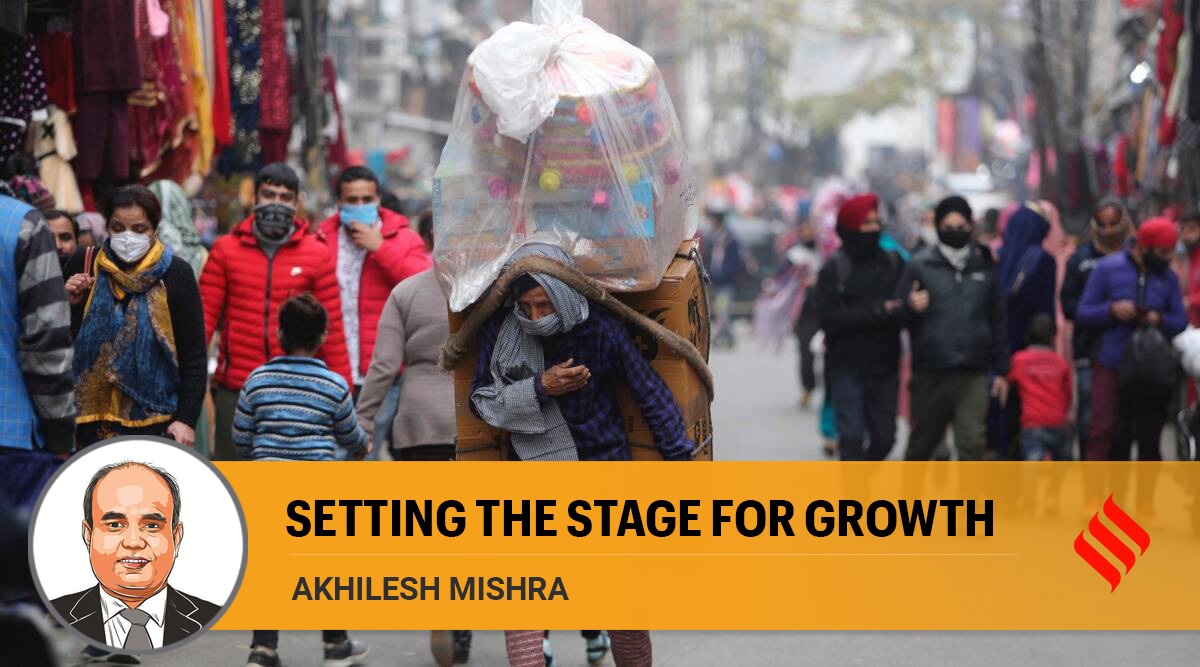 A man wearing a face mask as a precaution against the coronavirus carries boxes of toys at a market in Jammu, Friday, Jan. 21, 2022.(AP Photo/Channi Anand)
A man wearing a face mask as a precaution against the coronavirus carries boxes of toys at a market in Jammu, Friday, Jan. 21, 2022.(AP Photo/Channi Anand) The budget for FY 2022-23 has been presented in unique circumstances. Read along with the Economic Survey, it offers a convincing case of its economic management. Legacy issues have been resolved and the stage set to make this India’s decade of growth. In an earlier speech, PM Narendra Modi referred to the 2020s as “techade”. It may also be the “growthade”.
Consider the structural legacy issues inherited from the UPA and how they have been resolved.
First, the chronic NPA problem. Solved. Gross and net NPA ratios are steadily declining. Second, low bank capitalisation was adversely affecting credit, thereby affecting investment. Solved. The capital-to-risk weighted ratio is now over 16.5 per cent from below 13 per cent in 2013-14. Third, the indirect taxation mess was hampering capital efficiency. Solved. GST has now stabilised, with over Rs 1.4 lakh crore collections in January 2022. Fourth, sluggish private sector investment. Solved. There has been record resource mobilisation through IPOs from a low of Rs 1,500 crore in 2013-14 to 1.04 lakh crore in 2021-22 (April-December). Fifth, stalled infrastructure creation. Solved. National highways doubled from 71,772 km in 2011 to 1,40,152 km in 2021. Operationalised airports doubled from 62 in 2016 to 130 in 2021. Sixth, stalled privatisation and disinvestment. Solved. The privatisation of Air India is now complete. Other sectors like space, IT-BPO, drones, coal mining and geospatial mapping have been deregulated.
The pandemic created its own problems. Yet, India today is the fastest-growing major economy in the world, with growth pegged at 9 per cent or above by most major financial institutions. Here is how the budget sets the agenda for the “growthade”.
First, by empowering the future industry. The taxation of virtual digital assets will bring them into the mainstream, making India a hub for the productive use of this resource. The drone industry, already opened to private enterprise, has been given a huge captive market by integrating it with agriculture. The battery interoperability protocol for electrical vehicles is potentially a game-changer as it resolves the conundrum of long charging times. The introduction of the government’s own digital currency, using blockchain, will further boost the digital economy.
The time frame for availing the 15 per cent tax rate for new manufacturing units being extended till 2024 and tax incentives for start-ups being extended by a year will give impetus to sectors that have flourished in the last few years and created jobs. With over 25 per cent spending reserved for private-sector R&D and over 68 per cent of the defence procurement budget reserved for domestic industry, the military-industrial complex is finally on its way in India.
Second, empowering the 80 per cent to empower India. The hugely successful ECLGS scheme, which provides credit to the MSME sector, has been extended by another year with an overall outlay of Rs 5 lakh crore, and Rs 50,000 crore is reserved for just the hospitality sector. With over Rs 2.7 lakh crore budgeted for direct benefits transfer to farmers as MSP, the rural economy will continue to be infused with cash. The huge increase in capex and infrastructure spends, especially in rural areas — such as the Rs 48,000 crore for housing and Rs 60,000 crore for household tap water — will create a virtuous cycle of jobs, consumption and growth in the rural sector.
Third, a cycle of investment, which creates jobs that generate higher incomes, inducing greater consumption and driving higher growth, thereby fueling more investment. All the enhanced investment is in productive assets, and they create jobs across the skills value chain: Unskilled to semi-skilled jobs in rural areas through PMGSY and housing (over 80 lakh houses) and tap water connectivity (over Rs 1 lakh crore), semi-skilled jobs through Gati Shakti and national highway construction (25,000 km), skilled jobs in manufacturing sector, highly skilled top-end jobs in startups and high-end tech jobs in the defence manufacturing industry. The PLI schemes will generate over 60 lakh jobs and over Rs 30 lakh crore of new production.
Taken together, the economic management by the PM’s team and the budget proposals are well-positioned to make India the growth driver of the world economy in the 2020s. This “growthade” will be the story to watch out for.
This column first appeared in the print edition on February 2, 2022 under the title ‘Setting the stage for growth’. The writer is CEO, Bluekraft Digital Foundation and was earlier director (content) MyGov
- The Indian Express website has been rated GREEN for its credibility and trustworthiness by Newsguard, a global service that rates news sources for their journalistic standards.

